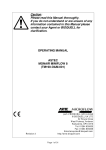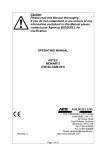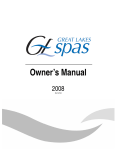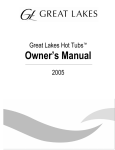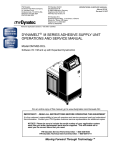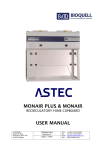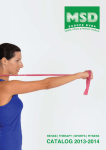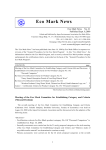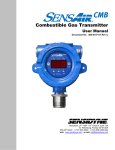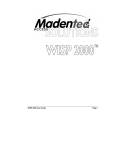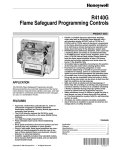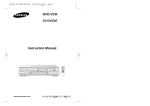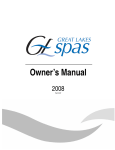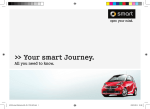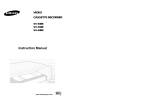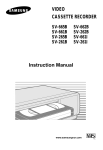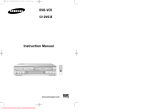Download Astec Monair 10-30
Transcript
Caution: Please read this Manual thoroughly. If you do not understand or are unsure of any information contained in this Manual please contact your Agent or Astec Microflow Ltd. for clarification. OPERATING MANUAL ASTEC MONAIR RANGE (10, 15, 20, 25, 30) Ref: CC/PM/06/00 Astec Microflow Limited 30/31 Lynx Crescent Weston-super-Mare North Somerset BS24 9BP Tel: 01934 410500 Fax: 01934 410542 http://www.astec-microflow.co.uk CONTENTS Warranty Information 1 Introduction 2 Installation 3 Fitting and Removal of Filters 4 General Operating Instructions 5 Control Panel/Display Board 6 Monitoring 7 Maintenance 8 In Case of Difficulty 9 Filter Types 10 Chemical Applications 11 Occupational Exposure Limits 2000 12 Specification Appendices 1 Notes on COSHH Regulations (UK Only) 2 Low Airflow Alarm - Testing and Calibration 3 Airflow Adjustment 4 Filter Saturation Alarm - Testing and Calibration 5 Electrical Diagram 6 UK Approved Service Companies Telephone and Fax Numbers 7 Protocol for Testing, Monitoring, Replacement and Disposal of Filters 8 Care and Cleaning Important, please read this manual before using this equipment. Thank you for purchasing our Astec Microflow product. We are confident that you will be completely satisfied with its design, function and quality. Export and Agent Sales Only Your warranty arrangements will be with your Agent. Please confirm the warranty directly with your Agent. UK Sales Only To register the product for our warranty you can either copy this page and fax the details below to us on 01934 410542 or e-mail [email protected]. Full conditions of our warranty and how to arrange a warranty visit are on the next three pages. The units are calibrated for airflow before leaving the factory however trained personnel can recalibrate them on site. If you require any help, advice, or have any problems please contact us on our Technical Help-Line 0800 716107. If a warranty visit is required please complete the Warranty Visit Request Fax and send to us on 01934 410542. WARRANTY REGISTRATION FAX HOSPITAL / COMPANY CONTACT TELEPHONE NUMBER AND EXTENSION ADDRESS EQUIPMENT MODEL SERIAL NUMBER LOCATION PLEASE TICK IF YOU REQUIRE DETAILS OF OUR SERVICE RECOMMENDATIONS AND PRICES Warranty and Liability Astec Microflow produces products that are warranted under normal usage against defects in workmanship and materials for one-year parts and labour costs, from the date of manufacture. The Warranty is stated in the Standard Terms and Conditions of sale. Export and Agent retailed products are warranted directly by the Agent. Please confirm your warranty and liability status with the Agent. In addition, the Warranty is void unless the following conditions are met: (a) The Warranty Registration Fax has been returned to Astec Microflow UK. The Warranty Registration Fax is located on the previous page. (b) The product has been installed and used as stated within the Instruction Manual. (c) The warranty does NOT include servicing or maintenance. An approved service company who have attended our training courses for your product must carry out maintenance of product. Failure to maintain or service this product will invalidate the warranty. Maintenance must be carried out in accordance with the Service Manual and include tasks within stated periods. Failure to use approved service companies or Astec Microflow trained personnel for maintenance also affects the CE Marking status of the product, removing Astec Microflow’s Duty of Care and responsibility under the following European Directives: (i) Medical Device ** (ii) EMC (iii) LVD (d) Supplies used with the product, such as cleaning solutions **, disinfectants **, are not covered by this Warranty. (e) Consumables such as carbon filters, pre-filters, HEPA filters, light bulbs and tubes, not warranted. (f) This Warranty is void if faults are caused by accidental damage, mishandling, adjustment by unauthorised personnel or failure to follow the correct maintenance and safety precautions as stated in the Instruction Manual. (g) The Warranty expressly provided for herein is the sole Warranty provided in connection with the product and no other Warranty, expressed or implied, is provided. Astec Microflow assumes no responsibility for any other claims, consequential (including lost time or profit) or other damage, whether based in contract, tort or otherwise, not specifically stated in this Warranty. (h) Except in respect of death or personal injury caused by Seller’s negligence, or as expressly provided in these Conditions, Seller shall not be liable to Buyer by reason of any representation (unless fraudulent), or any implied warranty, condition or other term, or any duty at common law, or under the express terms of the Contract for any loss of profit or any indirect, special or consequential loss, damage, costs, expenses or other claims (whether caused by the negligence of Seller, its servants or agents or otherwise) which arise out of or in connection with the supply of the Goods or their use or resale by Buyer, and the entire liability of Seller under or in connection with the Contract shall not exceed the price of the Goods. Note: When requesting a Warranty visit, please have the following information available: (i) Product model number and name. (ii) Serial number. (iii) Date of last service, and Service Company. (iv) Nature of fault and any other comments likely to indicate cause of fault. (v) A Purchase Order number to cover costs incurred if visit is outside the scope of the Warranty. Astec Microflow, or our sister company Servicecare, or other nominated personnel will carry out warranty visits. (j) In the event of any health and safety incidents please advise us in writing at the earliest opportunity. (k) This warranty and all other contractual issues shall be governed by English law and the parties agree to submit to the nonexclusive jurisdiction of the courts of England. Items marked ** are relevant to our Safescope models Please copy before use. WARRANTY VISIT REQUEST FAX Customer name …………………………………………………………………………………………….…… Location of product including address and contact telephone number ………………………………………………………………………………………………… ………………………………………………………………………………………………… ………………………………………………………………………………………………… ………………………………………………………………………………………………… ………………………………………………………………………………………………… Product model number and name …………………………………………………………………………………………………. Serial number (on front or right hand side on unit) …………………………………………………………………………………………………. Date of last service, and Service Company …………………………………………………………………………………………………. Nature of fault and any other comments likely to indicate cause of fault ………………………………………………………………………………………………… ………………………………………………………………………………………………… ………………………………………………………………………………………………… ………………………………………………………………………………………………… ………………………………………………………………………………………………… ………………………………………………………………………………………………… ………………………………………………………………………………………………… ………………………………………………………………………………………………… ………………………………………………………………………………………………… ………………………………………………………………………………………………… ………………………………………………………………………………………………… ………………………………………………………………………………………………… ………………………………………………………………………………………………… ………………………………………………………………………………………………… ………………………………………………………………………………………………… ………………………………………………………………………………………………… ………………………………………………………………………………………………… ………………………………………………………………………………………………… ………………………………………………………………………………………………… Purchase Order number to cover costs incurred if visit is outside the scope of the Warranty ………………………………………………………………………..……………. Export Only Please fax to your product Agent. UK Only Please fax to 01934 410542. 1. INTRODUCTION The Monair fume cupboard has been designed to produce a unit that will provide operator safety with an easy to use cabinet. The main work area has a face velocity of >0.5 m/sec to provide containment of fumes. The work surface is polypropylene and will contain spillages. The head unit contains the mains switch, low airflow alarms, carbon filter and optional lights and safety filter. The five units in the range vary in filter volume and size only. MONAIR 10 1 x 10 kg filter MONAIR15 2 x 10 kg filters MONAIR 20 2 x 10 kg filters MONAIR 25 2 x 10 kg filters 3 x 10 kg filters or MONAIR 30 3 x 10 kg filters 2. INSTALLATION WARNING: INSTALLATION SHOULD ONLY BE CARRIED OUT BY TRAINED AND APPROVED ENGINEERS OR AGENTS. ASTEC MICROFLOW OR ITS AGENTS CANNOT ACCEPT RESPONSIBILITY FOR DAMAGE, LOSS OR INJURY CAUSED BY, OR RESULTING FROM, INCORRECTLY INSTALLED EQUIPMENT. The units are supplied with an open base and can be positioned over an existing utility such as a sink, or on a balance bench, or can be used with the removable spillage tray. The unit is complete with an electrical plug and only requires the fitting of the filters. The plug is fitted with a 5 amp fuse. MONAIR 10 ASSEMBLY Place the fume cupboard base unit on the bench in the required position. Place the head unit on top of the cupboard. Slide the spillage tray into the base of the cupboard section. If a drip cup and tap are supplied, the tray will be fixed in the base of the cupboard and is not removable. Connect the mains lead into the socket on the right hand side of the head unit and plug into a 13 amp supply. FILTERS The filters for the unit are packed separately and require fitting into the machine before operation. Fitting of filters - the filters are located in the head unit. MAIN FILTER Fitting 1. Open the front access panel. Carefully lift off and remove the electric earthing connection. 2. Release the clamp mechanism by pulling the handle out and across the unit. 3. Slide the filter into the unit locating the end lugs in the guide rails, and push back until the back stop is reached. 4. Clamp the filter by moving the handle from left to right into the unit. 5. Replace the door, refit earthing strap and lock into place. PRE-FILTER The white pre-filter is supplied ready to fit. The supporting frame is located on four retaining clips on the underside of the head unit. The pre filter is laid on the retaining frame and the frame is then pushed up into the retaining clips. Access to insert the retaining frame and pre-filter are from inside the main cupboard unit. MONAIR 15,20,25 ASSEMBLY Place the fume cupboard base unit on the bench in the required position. Place the head units on top of the cupboard. Place the top control panel on top of the filter boxes and in front of the fan boxes. Connect the tubing for the low airflow alarm and filter saturation alarm (if fitted) as shown in the diagrams. Slide the spillage tray into the base of the cupboard section. If a drip cup and tap are supplied, the tray will be fixed in the base of the cupboard and is not removable. Connect the mains lead into the socket on the right hand side of the head unit and plug into a 13 amp supply. Fitting of filters is identical to the Monair 10 unit. Two filters are fitted in the head units one in each clamp arrangement. Two pre-filters are fitted in the units, one before each main carbon filter. AIRFLOW If on checking the airflow, the reading is below the required 0.5 m/s (with the door flaps closed) the fan can be regulated as per the instructions in Appendix 3. MONAIR 30 (MONAIR 25, 3 FILTER VERSION) ASSEMBLY Place the fume cupboard base unit on the bench in the required position. Place the head units on top of the cupboard. Place the top control panel on top of the filter boxes and in front of the fan boxes. Connect the tubing for the low airflow alarm and filter saturation alarm (if fitted) as shown in the diagrams. Slide the spillage tray into the base of the cupboard section. If a drip cup and tap are supplied, the tray will be fixed in the base of the cupboard and is not removable. Connect the mains lead into the socket on the right hand side of the head unit and plug into a 13 amp supply. Fitting of filters is identical to the Monair 10 unit. Three filters are fitted in the head units one in each clamp arrangement. Three pre-filters are fitted in the units, one before each main carbon filter. AIRFLOW If on checking the airflow, the reading is below the required 0.5 m/s (with the door flaps closed) the fan can be regulated as per the instructions in Appendix 3. Monair 20 Plastic Pipe Connections Stage 1 - Gastec Connection LH RH One pipe direct to Gastec port red plastic hole Should not involve plastic T joining pieces but tube increaser is used Monair 20 Plastic Pipe Connections Stage 2 - Filter Saturation RH LH Filter saturation alarm to one chamber with rubber boot Should not involve plastic T joining pieces Monair 20 Plastic Pipe Connections Stage 3 - Airflow Connections RH LH Both chambers linked via plastic T to grey plastic pressure sensor White or blue plastic T junction Monair 30 Plastic Pipe Connections Stage 1 - Gastec Connection LH RH One pipe direct to Gastec port red plastic hole Should not involve plastic T joining pieces but tube increaser is used Monair 30 Plastic Pipe Connections Stage 2 - Filter Saturation RH LH Filter saturation alarm to one chamber with rubber boot Should not involve plastic T joining pieces Monair 30 Plastic Pipe Connections Stage 3 - Airflow Connections LH RH All three chambers linked via plastic T to grey plastic pressure sensor White or blue plastic T junction 3. FITTING AND REMOVAL OF FILTERS The protocol for testing, monitoring, replacement and disposal of filters is detailed in Appendix 7. Hazards associated with the removal and disposal of used filters will depend on the use to which the filtration fume cupboard has been put. If an activated carbon filter is used with hydrocarbon solvents, the filter will retain the solvents without loss, and can be removed in the open laboratory. A pair of plastic gloves and a plastic bag are supplied with each filter. The plastic gloves should be used when removing filters. The used filters should be placed in the plastic bag and sealed prior to waste disposal, preferably by incineration. If dangerous materials such as asbestos dust or radioactive chemicals have been contained by the filter, then operator protection which includes the use of respirators and protective clothing may be required. The used filter may require disposal by a specialist company. As the conditions of use are outside ASTEC's control, it is the responsibility of the user to ensure that any personnel changing filters are advised of any potential hazards in handling the filters, and are provided with any necessary protective equipment or clothing. The safety officer in your organisation can normally advise. PRE-FILTERS The pre-filters are located inside the main cupboard area on a supporting frame located on four retaining clips directly under the head and main carbon filter. Open the front cupboard door and pull the frame downwards out of the two front retaining clips. Remove the dirty pre-filter and place in a plastic bag, seal the bag ready for disposal. The clean pre filter is laid on the retaining frame and the frame is then pushed up into the retaining clips. Return the door to normal operating position. MAIN CARBON FILTERS Changing the filters is identical for all the models. The Monair 10 contains 1 filter, the Monair 15, 20 and 25 have 2 filters and the Monair 25 (alternate version) and Monair 30 have 3 filters. All filters are the same size and fit all models. Carefully open the front panel on the head unit and disconnect the earthing strap. Put on plastic gloves supplied with the new filter. Release the clamping mechanism by pulling the handle forward and across the front of the unit. Pull the filter forward by its handle until the clamp mechanism guide rails are fully extended. Lower the front of the filter with the yellow lugs still locate in the fully extended guide rails allowing the filter to hang as shown. Slide the plastic bag supplied up over the filter. Remove the filter from runners and seal the bag. The filter is ready for disposal. The preferable method of disposal is incineration. Slide the new filter into the unit locating the yellow lugs in the guide rails. Push back until located against the back stop. Move the filter clamping handle back across the unit and into the head. The filter is now evenly clamped in position. Replace the front door panel, ensuring the earthing strap is reconnected. SAFETY FILTERS (IF FITTED) To remove the safety filter undo the screws on the retaining frame on the top of the head unit. Put on plastic gloves supplied. Lift the filter out and place in the plastic bag provided. Seal the bag and the filter is ready for disposal. The preferred method of disposal is incineration. Place the new filter on the top of the exhaust with the foam seal downwards. Screw the retaining frame in place to seal the filter securely. 4. GENERAL OPERATING INSTRUCTIONS 1. The fume cupboard may only be operated with the correct filter installed for the application. Refer to Sections 9 and 10 of this manual for further information. If in doubt, call ASTEC directly, or contact your local dealer. 2. To start the units, switch the power switch on. The fan will automatically run to give 0.5 m/s. 3. Check the airflow and filter saturation on a regular basis. Section 5 of this manual describes monitoring systems in greater detail and discusses COSHH requirements. 4. The face velocity at the working aperture (and therefore containment of fumes) is at a maximum with the front lower flap in the closed position. The unit should be used in the closed position whenever practical. 5. A Bunsen burner or other heat source should not be placed too close (<150 mm) to the side or back panels. It is not recommended that an open flame or heat source be positioned closer than 300 mm from the bottom of the filter bed. 6. All units are provided with a polypropylene spillage tray that has good chemical resistance. 7. It should be noted that filterblocks do not absorb carbon monoxide or hydrogen. However small quantities (such as used in schools) will not present a hazard because of the large dilution factor from the airflow through the fume cupboard, and retardation of the chemical in the filter matrix. 8. ASTEC fume cupboards are designed to handle fumes and vapours given off during normal laboratory procedures. These will be at the ppm level in the airstream entering the filter block. It is NOT recommended that large quantities of solvents or acids should be boiled off in the fume cupboard. 9. Always keep a spare set of filters available. 10. High concentrations of fumes entering the filterblock may temporarily reduce the filtration efficiency. For this reason any major spillage within the fume cupboard should be cleared up immediately, preferably using spillage absorption granules (available from BDH or other laboratory supply houses), rather than tissue paper which may aggravate the evaporation of toxic fumes from the spillage area. 11. Following a major spillage, the main filters must be changed, as the heat of wetting may reduce filter efficiency. After stabilisation, the old filters can normally be re-used, provided saturation has not been reached. 12. The electrical equipment in the cabinet including light fittings and control equipment are in separate enclosures, on the clean side of the filter. The equipment should not be used in a flammable room atmosphere. Specially modified equipment can be provided for use in solvent rooms. Contact ASTEC or your local dealer/distributor for further information. 5. CONTROL PANEL/DISPLAY BOARD LOW AIRFLOW FILTER ALARM (OPTIONAL) HOUR COUNTER ON/OFF MAINS ON/OFF Press the switch down to switch on. A green indicator lamp will indicate that power is connected to the unit. The fan will run at full speed, ready for normal operation of the fume cupboard and the lights, if fitted, will come on. The cupboard can be used immediately. HOUR COUNTER This indicates the total number of hours running time of the fan. LOW AIRFLOW ALARM The alarm is a red light located at the front of the unit. In normal operation, the red light will not come on. If the red indicator lamp starts to flashes on intermittently or stays on, the pre-filter is starting to block with dust and an airflow reading should be taken at the aperture to determine if the pre-filter requires changing. We advise changing the pre-filter if an airflow of 0.3 m/sec cannot be maintained. The correct operation of the alarm may be tested as described in Appendix 2, instructions on replacing filters are given in Section 3 of this manual. FILTER ALARM/STATUS (IF FITTED) The green LED is constantly displayed while the filter is actively absorbing the chemical fumes. The light goes out every six seconds as the mechanism samples the air stream. When a chemical breakthrough is detected the red light comes on intermittently and an audible alarm bleeps 4 times every minute showing the filter requires changing. See Appendix 4 for calibration and testing. ACID DETECTION SYSTEM (IF FITTED) A simple optional detector system for inorganic acid gases can be fitted to the fume cupboard. The green LED will indicate the absence of acid gases, and a red LED will alert the user to acid fumes in the return air to the laboratory, an audible alarm will also sound. TESTING THE ACID DETECTOR ALARM The alarm can be simply checked by removing the indicator paper from the holder as follows: 1) Switch on the unit, the green LED should be on. 2) Open right-hand cupboard door. 3) Slide the cover off the detector. 4) Remove the indicator paper. The green LED should go out, the red LED will come on and the alarm sound. Insert the detector paper, green light should come back on. 6. MONITORING GENERAL Under the "Control of Substances Hazardous to Health" (COSHH) regulations, it is mandatory to check safety equipment at "suitable intervals" for correct operation. A suggested maintenance schedule is given in Section 7 of this manual. This section of the manual reviews the manual methods of checking the unit. The purpose of monitoring is to detect when the pre-filters or main filters cease to operate effectively. If the pre-filters are blocked, the airflow will be reduced at the fume cupboard aperture. If the main filters are saturated, they will cease to remove the fumes effectively. The Monair units are fitted with a low airflow alarm. Details for testing and calibration are in Appendix 2. The Monair units do not have any filter saturation detectors. You should carry out a manual check of filter saturation once every three months, as described below. If an odour is noticed, it is sensible to check the fume cupboard. However, it must be remembered that the sense of smell is very sensitive for some chemicals (e.g. ammonia or hydrogen sulphide) and a slight smell does not mean that the exhaust levels of chemical have approached the maximum acceptable concentration. MANUAL MONITORING Manual monitoring should be carried out yearly to check the integral systems on the unit. AIRFLOW MEASUREMENTS An anemometer should be used to check the airflow (face velocity) at the working aperture, with the lower panel down. Any suitable anemometer may be used, including hot wire, propeller or vane anemometer. A minimum of six readings should be taken across the working aperture. Note the result in a record book kept for this purpose. This is mandatory under COSHH regulations. We advise changing the pre-filter if the average airflow drops below 0.5 m/s. The pre-filters will normally need to be changed more frequently than the main filters. A blocked HEPA filter (where fitted) is also indicated by reduced airflow which is not restored after a pre-filter change. MANUAL FILTER SATURATION DETECTION 1. Select a suitable test chemical and matching Gastec sampling tube. Examples include alcohols, toluene, trichloroethylene, or any suitable chemical in routine use in the fume cupboard, provided it is well adsorbed and is not dangerously toxic. 2. Place 6 ml of chemical in a beaker on a hotplate. Adjust the hotplate to boil off the chemical in about two minutes. This gives a concentration of about 100 - 200 ppm to challenge the filter. Use 3 ml of chemical for Monair 10. 3. For testing ACI filters (acid adsorbing), or multi-filters with acid adsorbing layers, use sulphur dioxide gas (SO2) at 2 bubbles per second through water (1 bubble per second for Sensair 10). 4. Using the Gastec tube, sample the outlet airstream from the unit, following the instructions given with the Gastec tube (one pump stroke for trichloroethylene, eight pump strokes for sulphur dioxide for example). 5. The reading should be below the Occupational Exposure Limit (see Section 11). Enter the result in a record book kept for this purpose. This is mandatory under COSHH regulations. 6. If a significant level of chemical is noted in the exhaust air, the main filter should be changed. 7. MAINTENANCE IMPORTANT NOTICE Under the "Control of Substances Hazardous to Health" (COSHH) regulations, effective from 1st October 1989, it is mandatory to maintain written records of checks, tests and repairs carried out on safety equipment, and these records must be kept for 5 years. A summary of COSHH regulations are provided in Appendix 1. Regular maintenance will reduce the possibility of hazard to the operator and prolong the life of the fume cupboard. WARNING! Before attempting any inspection or replacement of electrical components in the head assembly, always isolate the fume cupboard from the mains electricity supply. AIRFLOW The Monair units are fitted with a low airflow alarm. With this model you should test the alarm once a year as described in Appendix 2 of this manual, to ensure it is operating correctly. FILTER SATURATION The Monair units do not have any filter saturation detection systems. The filter condition should be monitored regularly, i.e. every 3 months or more frequently if required. CLEANING AND INSPECTION You should carry out the following procedures at six monthly intervals: 1. Remove the spillage tray (where fitted) and wash in dilute detergent solution. 2. Wash the interior surface of the cupboard with dilute detergent solution. 3. Inspect the cupboard frame and panels for mechanical damage. 4. Inspect the hinged door for corrosion and correct adjustment of friction hinges (where fitted). The following checks should be made every 12 months. 1. Check the condition of services to the cupboard, including water supply, drip cup, waste drain (where fitted), gas supply (where fitted) and electric cable and plug. 2. The electrical earthing and insulation should be inspected by a qualified electrician. 3. Check the fan for correct running, and the tension on the butterfly nut holding the regulating plate in place to ensure it is tight. 8. IN CASE OF DIFFICULTY WARNING! BEFORE ATTEMPTING ANY INSPECTION OR REPLACEMENT OF ELECTRICAL COMPONENTS IN THE HEAD ASSEMBLY, ALWAYS ISOLATE THE FUME CUPBOARD FROM THE MAINS ELECTRICITY SUPPLY. Electrical components are mounted behind the control panel. To access the electrical components, remove the two retaining screws which secure the control head to the fan box(es), lift upwards then, if required, disconnect the electrical/tubing connections. Some possible problems and their causes are shown below: 1. Unit will not operate, no lights or airflow: a) Check that unit is plugged in and switched on. b) Check fuse in mains supply or plug (where fitted). c) Check fuses in electrical input socket. 2. Unit operates, but one or both fluorescent lights do not come on (if fitted). Open the front door of the head unit to gain access to the lights. Disconnect the electrical connection and remove the two screws. The light box can now slide forward for examination. a) Ensure light tube correctly seated. b) Replace starter lamp. c) Replace fluorescent tube. 3. Fan does not operate, a) Change motor start capacitor on fan. Access to fan is by removing the panel or safety filter (if fitted) on top of the unit. b) Motor failure - contact ASTEC or your local distributor for advice. 4. Fan operates initially, but then cuts out. Motors are fitted with a thermal cut-out device, which will operate if the motor temperature rise exceeds 95°C. The most likely cause of overheating is a blockage of the airflow, either at the filters or at the exhaust outlet at the top of the unit. Low airflow alarm will operate. 5. Low airflow light - the red indicator lamp comes on at switch on and stays on. a) The pre-filter is blocked with dust. b) If replacement of the pre-filters does not cause the red light to stay off, then the low airflow alarm required recalibration, as described in Appendix 2. FOR FURTHER ADVICE PLEASE CONTACT THE ASTEC HELPLINE ON 0800 716107 OR YOUR LOCAL DISTRIBUTOR. 9. FILTER TYPES PRE-FILTERS Filtrete pre-filter. This is a high performance pre-filter, designed to remove particulates from the airstream. The filter material is based on electrets, which are permanently charged di-electrics. They remove particulates from polluted air by strong electrostatic forces generated by the fibres from which they are made. The combination of strong electric charge and open structure provides a filter with high efficiency, low airflow resistance and high loading capacity. Measured efficiency figures for particles in the 0.5 - 2.0 micron range is 99%, with loading capacities up to 113 g/m². Filtrete will remove fine particles, aerosols and mists. MAIN FILTERS Fourteen different types of filter media are available for the main filter bed. Most of these are impregnated activated carbon, to provide a higher filter capacity for lower molecular weight organic compounds and inorganic gases and vapours. A number of filter efficiency studies have been carried out, and all results using single bed filters show efficiencies very close to 100%. GP Filter. The most widely used filter in the range, primarily for solvent fume removal. It is manufactured from coconut-shell based activated carbon of 5-10 mesh size and surface area up to 1300 m²/gm. Filtration is achieved by the physical adsorption of molecules in the pores of the activated carbon by Van de Waals forces. This filter will remove any chemical with a molecular weight greater than 30 and a boiling point greater than 60°C. ACR Filter. This filter is impregnated with halide salts, and is used for the high efficiency removal of radioactive iodine and methyl iodide. It is frequently used for iodination reactions with low-level radioactive iodine, and efficiencies in excess of 99.99% have been measured. ACM Filter. This filter is impregnated with iodine compounds for removal of mercury vapour. The filter has been demonstrated to remove mercury from a saturated airstream at ambient temperature to below 5 parts per billion (ppb) in the exhaust airstream. AMM Filter. This filter is impregnated with copper compounds to efficiently remove vapour from dilute ammonia solutions, and to remove low molecular weight amines. ACI Filter. This alkali impregnated filter will neutralise volatile inorganic acid vapours such as hydrochloric and hydrofluoric acids, and acid gases such as sulphur and nitrogen dioxides. SUL Filter. A potassium iodide impregnated filter, designed to remove hydrogen sulphide and low molecular weight mercaptans. CYN Filter. A multi-impregnated filter to a military specification, for removal of hydrogen cyanide gas. Many cyanide compounds will evolve HCN gas if acidified, so this filter is normally specified if working with any cyanide compound. FOR Filter. This filter is impregnated with an oxidising agent to oxidise formaldehyde to formate salts. It is widely used in hospital pathology laboratories. ETH Filter. Diethyl ether is adsorbed on activated carbon, but because of its low boiling point, the local heat of adsorption can reduce the capacity of the filter. Special impregnation allows a chemical reaction which increases filter capacity. MIL Filter. As the name implies, this filter is multi-impregnated to handle a wide range of chemicals defined by the Ministry of Defence. It will efficiently remove solvent fumes, acid fumes, hydrogen sulphide, cyanides and arsine at high efficiency (>99%) but has a somewhat reduced capacity compared to single impregnated filters. It contains noble metals, and is thus rather expensive. OAL Filter. This odour filter is normally used in air purifiers to deal with odours from excreta, urine and other materials essentially alkaline in nature. OAC Filter. Air purifier odour filters for human and animal acid type smells caused by bacterial decay, such as cadaverine and putrescine, and other odours which are acidic in nature. HEPA Filter. The High Efficiency Particulate Air filter is a pleated glass-fibre material sealed with epoxy resin in an aluminium frame. Each filter is tested to ensure a stated particle filtration efficiency (usually 99.997%) according to US Standard 209B or BS 3928. A HEPA filter is sometimes known as an absolute filter. EDU Filter. The EDU filter has been specially formulated to adsorb the normal range of chemical fumes generated in Schools during GCSE and 'A' level classes. MULTIPLE LAYER FILTERS Fume cupboards may be fitted with filters that have up to four layers of filter material in one filter block. In addition, filters which are 50% HEPA and 50% carbon based may be supplied for particulate and chemical uses. Advice is available from ASTEC on the choice of filterblock for specific applications. Contact our Chemist on 0800 716107. 10. CHEMICAL APPLICATIONS INTRODUCTION The table overleaf gives a list of common laboratory chemicals, together with the filter recommended and an estimate of filter capacity. The recommended filter is the main single-layer filter used for the application. It may be possible to use other filters, such as the MIL filter or a Multi Layer filter. In all cases the filter efficiency for a single layer filter will be close to 100%. Chemicals marked * are poorly absorbed by all filters and should be used in small quantities only. Their exhaust concentration may however be quite low due to dilution with air and retardation in the filter matrix. The filter capacity is given as the equilibrium saturation capacity, a standard test procedure for activated carbon (ASTM-D3467). The capacity is expressed as the final filter weight at saturation as a percentage of initial filter weight. In many cases these values have been determined by experiment, in other cases estimated values are used based on experience with activated carbon material and a knowledge of the chemical structure. The actual capacity obtained will depend on the conditions of use, but the breakthrough point to reach the OEL of the chemical may be up to 70% of this value for normal input loadings. Chemical Filter Equilibrium Type Saturation Capacity % Acids Acetic Acetic anhydride Acrylic Butyric Caprylic Carbolic Formic Lactic Osmium tetroxide Palmitic Phenol Proprionic Valeric GP GP GP GP GP GP ACI GP GP GP GP GP GP 33 33 40 40 40 40 20 40 40 40 40 40 40 Alcohols Ethyl Amyl Butyl Cyclohexanol Isopropyl Methyl (methanol) Propyl GP GP GP GP GP GP GP 32 40 40 45 40 32 40 Aliphatic Hydrocarbons Acetylene GP Iso-butane GP Butylene GP Butadiene GP Cyclohexane GP N-decane GP Ethane * GP Ethylene * GP N-heptane GP Heptylene GP Hexane GP Hexylene GP Methane * GP N-nonane GP N-octane GP N-octylene GP Pentane GP Propane * GP Propylene GP 20 10 10 35 35 26 10 Aromatic Hydrocarbons Benzene GP Napthalene GP Ninhydrin GP Styrene monomer GP Toluene GP Toluidine GP Xylene GP 40 47 47 47 47 47 40 Esters Butyl acetate Cellosolve acetate Ethyl acetate Ethyl acrylate Ethyl formate Isopropyl acetate Methyl acetate Methyl acrylate Methyl formate Methyl methacrylate 40 45 40 45 40 45 40 45 40 45 GP GP GP GP GP GP GP GP GP GP Aldehydes and Ketones Acetone GP Acetaldehyde FOR Acrolein GP Benzaldehyde GP Butyraldehyde GP Caproaldehyde GP Crotonaldehyde GP Cyclohexanol GP Diethyl ketone GP Dipropyl ketone GP Formaldehyde FOR Gluteraldehyde FOR Mesityl oxide GP Methyl butyl ketone GP Methyl ethyl ketone GP Methyl isobutylketoneGP Propionaldehyde GP Valeraldehyde GP Valeric aldehyde GP Ethers Amyl Butyl Cellosolve Dioxan Diethyl (ethyl) Ethylene oxide Isopropyl Methyl cellosolve Methyl * Propyl GP GP GP GP ETH GP GP GP ETH GP Halogens Bromine GP Butyl chloride GP Carbon tetrachloride GP Chlorine GP Chlorobenzene GP Chlorobutadiene GP Chloroform GP Chloro picrin GP Chloro nitropropane GP Dibromoethane GP Dichlorobenzene GP Dichlorodifluoro methane GP Dichlorodifluoro ethane GP Dichloroethylether GP Dichloromethane GP Dichloromonofluoro methane GP Dichloropropane GP Dichlorotetrfluoro ethane GP Ethyl bromide GP Ethyl chloride GP Ethylenechlorohydrin GP Ethylene dichloride GP Fluorotrichloro methane GP Freon (BP > -20°C) GP Hydrogen bromide ACI Hydrogen chloride ACI Hydrogen iodide ACI Iodine GP Iodoform GP Methyl bromide GP Methyl chloride GP Methyl chloroform GP Methylene chloride GP Monochlorobenzene GP Fluorotrichloro methane GP 32 10 32 40 32 40 40 40 32 40 10 10 40 40 32 40 32 40 40 35 35 40 45 10 20 25 45 10 30 53 40 65 20 53 40 60 65 60 60 60 20 40 53 53 20 53 20 20 20 40 53 50 45 5 5 7 55 53 25 20 45 45 45 45 Paradichlorobenzene GP Perchloroethylene GP Phosgene MIL Propyl chloride GP Tetrachloroethane GP Tetrachlorotheylene GP Vinyl chloride GP 45 45 20 40 53 53 20 Sulphur Compounds Carbon disulphide GP Dimethyl sulphate GP Ethyl mercaptan SUL Hydrogen sulphide SUL Mercaptans-high MW SUL Sulphur dioxide ACI Sulphur trioxide ACI Sulphuric acid ACI Tetrahydrothiapene GP 20 50 40 20 40 10 20 40 40 Nitrogen Compounds Acetonitrile CYN Ammonia AMM Amines - low MW AMM Amines - high MW AMM Aniline GP Diethyl amine AMM Diethyl aniline GP Dimethyl amine AMM Ethyl amine AMM Hydrogen cyanide CYN Indole GP Nicotine GP Nitric acid fumes ACI Nitrobenzene GP Nitroethane GP Nitrogen dioxide * ACI Nitroglycerine GP Nitromethane GP Nitropropane GP Nitrotoluene GP Pyridine AMM Urea GP Uric acid GP 20 10 10 40 40 20 53 20 20 20 53 40 10 53 53 53 40 40 53 53 53 53 Miscellaneous Adhesives Animal Odours Camphor Carbon monoxide * Carbon dioxide * Citrus fruits Cooking odours Deodorisers Detergents Hospital odours Human odours Leather Ozone Nicotine Perfumes Petrol Putrescine Resins Toilet odours 40 30 40 40 40 20 40 30 30 30 30 30 30 40 30 30 30 GP OAL GP GP GP GP GP GP GP OAC OAC GP GP GP GP GP OAC GP OAL 11. OCCUPATIONAL EXPOSURE LIMITS 2000 Occupational Exposure Limits are listed overleaf for some common laboratory chemicals. A full list may be obtained from: The Health and Safety Executive HSE Books PO Box 1999 Sudbury Suffolk CO10 6FS Tel: Fax: 01787 881165 01787 313995 The exposure limits are expressed in parts per million by volume (ppm) under the following headings: (a) LTEL - Long Term Exposure Limit (8 hour time weighted average reference period). (b) STEL - Short Term Exposure Limit (15 minute reference period). Gastec sampling tubes are available for * marked items. Items under review are marked UR. These Occupational Exposure Limits are supplied for guidance only. Current limits should be confirmed in the EH40 document available from the Health and Safety Executive. Note: These limits are correct at the time of publication of EH40/2000. As these limits can change annually, it is best practice to carry out an annual review for the materials in use. UK OCCUPATIONAL EXPOSURE LIMITS 2000 Aliphatic Hydrocarbons Butane * Butadiene Cyclohexane * Heptane * Hexane * Octane * Pentane * Aromatic Hydrocarbons Benzene * Napthalene Styrene Toluene * o-Toluidine * Xylene * Acids Acetic * Acetic anhydride * Formic * Phenol (Carbolic Acid) * Propionic Esters Butyl acetate * Ethyl acetate * Ethyl acrylate * Ethyl formate Isopropyl acetate * 2-Methoxy-ethyl acetate Methyl acetate Methyl acrylate * Methyl formate n-Propyl acetate * Aldehydes and Ketones Acetone * Acetaldehyde * Acrylaldehyde * Crotonaldehyde Cyclohexanol Diethylketone Formaldehyde * Glutaraldehyde Mesityl oxide Methyl butyl ketone Methyl ethyl ketone Methyl isobutyl ketone Nitrogen Compounds Acrylonitrile Ammonia * Aniline * Diethylamine * Dimethylamine * Ethylamine Nitric acid fumes * Nitrobenzene Nitroethane Nitrogen dioxide * Nitroglycerine Nitromethane 1-Nitropropane 2-Nitropropane Nitrotoluene Pyridine * LTEL 600 10 100 STEL 750 --300 20 --- 5 UR 100 50 0.2 100 --UR 250 150 --150 10 0.5 5 5 10 15 2 --10 15 150 400 5 100 --5 200 10 100 200 200 --15 150 200 --250 --150 250 750 20 0.1 1500 50 0.3 50 200 2 0.05 15 5 200 50 --250 2 0.05 25 --300 100 2 25 1 10 2 2 2 1 100 3 0.2 100 25 5 5 5 --35 --25 6 6 4 2 --5 0.2 150 ----10 10 Alcohols Butan-1-ol * Butan-2-ol * Cyclohexanol Ethanol * Isopropanol * 2-Methoxyethanol Methanol * Propan-1-ol * Halogens Bromine * Carbon Tetrachloride * Chlorine * Chlorobenzene * Chlorobutadiene Chloroform * Chloropicrin * 1,4-Dichlorobenzene Dichlorodifluoromethane 1,1-Dichloroethane 1,2-Dichloroethylene * Dichloromethane Dichlorofluoromethane Dichloropropene Dichlorotetrafluoroethane Ethyl bromide * Ethyl chloride Epichlorohydrin Ethylene dichloride Fluorotrichloromethane Hydrogen bromide Hydrogen chloride * Hydrogen fluoride * Iodine * Iodoform Methyl bromide * Methyl chloride Methyl chloroform * Trichlorofluoromethane Perchloroethylene * Phosgene * Tetrachloroethane * Tetrachloroethylene Trichloroethane Trichloroethylene * Vinyl chloride * Ethers 1,4-Dioxane * Diethyl ether* Ethylene oxide * Isopropyl Sulphur Compounds Carbon disulphide * Dimethyl sulphate Ethyl mercaptan * Hydrogen sulphide * Methyl mercaptan * Sulphur dioxide * Miscellaneous Camphor Carbon monoxide * Carbon dioxide * Ozone * Petrol * LTEL --100 50 1000 400 5 200 200 STEL 50 150 ----500 --250 250 0.1 2 0.5 50 10 2 0.1 25 1000 200 200 100 10 0.3 --1 ------0.3 50 1250 400 250 300 --- 1000 UR 1000 0.5 5 1000 --1 ----0.6 5 50 200 1000 50 0.02 1250 UR 1250 1.5 --1250 3 5 3 0.1 1 15 100 400 1250 100 0.06 50 200 100 7 100 400 150 --- 25 400 5 250 100 500 --310 10 0.05 0.5 10 0.5 2 ----2 15 --5 2 30 5000 --- 3 200 15000 0.2 12. SPECIFICATION AIRFLOW Volume of air treated Average face velocity (m/s) Lighting (optional) 15 W fluorescent tubes 10 15 20 25 30 225 >0.5 2 450 >0.5 3 450 >0.5 3 450/675 >0.5 3 675 >0.5 4 1 2 2 2/3 3 1 2 2 2/3 3 750 695 1210 800 1000 695 1210 800 1250 695 1210 800 1500 695 1210 800 1750 695 1210 800 FILTERS Main 565 x 350 x 110 mm – 10 kg Safety 450 x 495 x 40 mm – 4 kg (optional) SIZE Width (mm) Depth (mm) Overall height (mm) Internal working height (mm) ALL UNITS CONSTRUCTION Head and base unit Colour Back Panel Side Panels Front doors Spillage Tray Fan Epoxy coated mild steel frame and head Grey Clear acrylic Clear acrylic Clear acrylic Polypropylene Centrifugal type ELECTRICAL Voltage Supply Switches Fuses Power rating 230 V, 50 Hz, Single phase Mains ON/OFF 10 and 20 - 2 x 3 Amp 10 and 20 - Max 690 Watts OPTIONS 1. 2. 3. Internal lights Trolley or stand Electronic filter saturation alarm ENVIRONMENTAL CONDITIONS Indoor use only Altitude up to 2000 metres Temperature 10°C to 40°C Maximum relative humidity 80% for temperatures up to 31°C, decreasing linearly to 50% at 40°C. Main supply voltage fluctuations not to exceed ± 10% of nominal. Pollution degree 1. APPENDIX 1 NOTES ON COSHH REGULATIONS (UK ONLY) 1. The "Control of Substances Hazardous to Health" (COSHH) regulations, effective from 1st October 1989. 2. The regulations are the UK implementation of an EEC Council Directive 80/1107/EEC. 3. The regulations require an employer to protect his employees and any other people (whether working for him or not) from hazardous substances. 4. A hazardous substance is defined as: A. A substance which is on the list of hazardous substances as defined by the Classification, Packaging and Labelling Regulations 1984 (b). B. A substance for which an Occupational Exposure Limit (OEL) value exists. This list is similar to US Threshold Limit Value levels (TLV). C. A micro-organism which creates a health hazard. D. Dust at a substantial concentration in air. E. Any substance which creates a hazard to health, similar to the hazards created by the substances in A - D. NOTE paragraph 4E is a "catch-all" section. 5. The employer is responsible for assessing the risk to an employee. 6. The employer must prevent or control the exposure of an employee to hazardous substances. 7. The control of exposure "shall be secured by measures other than the provision of personal protective equipment". This means the fumes must be contained, rather than providing protective suits and masks to staff. 8. OEL values must not be exceeded. 9. The employer must ensure that safety equipment is properly used. 10. The employee must use safety equipment provided correctly. 11. The employer must maintain safety equipment in good working order. In particular, A. Exhaust ventilation equipment must be examined every 14 months. B. Other safety equipment must be examined at "suitable intervals". C. Records of checks, tests and repairs must be kept for 5 years. 12. Monitoring of exposure to hazardous substances must occur "in accordance with a suitable procedure". Records of results must be kept for 5 years for general monitoring and for 30 years when they relate to a specific employee. 13. Regular medical checks are required when working with certain listed substances, or where an identifiable disease is associated with a certain substance. 14. An employer must provide suitable instruction and training to employees regarding risks of substances and precautions to be taken. 15. Certain other regulations take precedence, such as Control of Lead at Work, Control of Asbestos at Work, radioactive, explosive or flammable regulations, Mines and Quarries Act, and medical treatment regulations. APPENDIX 2 LOW AIRFLOW ALARM – TESTING AND CALIBRATION TESTING THE LOW AIRFLOW ALARM CALIBRATION WARNING!! CALIBRATION OF THE PRESSURE SWITCH INVOLVES CONTACT WITH THE MAIN BOARD WHICH HAS ELECTRICAL CONTACTS AT MAINS VOLTAGE WHICH IS ALSO MAINS OPERATED. CARE SHOULD THEREFORE BE TAKEN WHEN CARRYING OUT THE CALIBRATION PROCEDURE. 1. Ensure that new pre-filters are fitted in your filtration fume cupboard. Switch on the unit, indicator lamp should be out. 2. Switch off unit. Block the pre-filters to give an airflow of <0.3 m/s. Switch on. The red indicator lamp will start to flash. 3. If a malfunction is indicated by steps 1 or 2, then a pressure switch calibration procedure may be required. Details are provided below. Remember to remove the plastic bags from the pre-filters before returning the unit to routine use! CALIBRATION PROCEDURE The low airflow alarm operates using a differential pressure switch detects a "high vacuum" situation caused by a blocked pre-filter. The pressure switch is carefully calibrated before leaving our factory, and in the majority of cases calibration will not be required. The factory calibration is carried out using a standard GP filter at 240, 220 or 110 V 50 Hz mains supply, depending on the market area. A standard Filtrete pre-filter is used. If the end-user is known (e.g. school) then the calibration will be performed using the correct main filter in place (e.g. EDU filter). In some cases it may be necessary to recalibrate the pressure switch in the customer's laboratory if the test procedure described above fails. The main reason for a test failure are: 1. 2. 3. A severe knock during transport A change in the mains voltage or frequency Use of a different main filter from that used during factory calibration. The pressure switch is located behind the control panel. The pressure switch is located by removing the grommet in the front control panel, and carefully insert a screwdriver to locate the control screw. The filtration fume cupboard should be fitted with main filter and new Filtrete pre-filter. Switch on, adjustable pressure. Wait 30 seconds to warm up. 1. Unscrew (anticlockwise) switch by 2 turns. The red warning light should now be off. 2. Screw switch clockwise until the red warning light JUST comes on. 3. Unscrew switch by 15 degrees (half hour on the Hour hand of a clock) so the red warning light goes out. 4. Check calibration by switching the unit off, and wrap the pre-filter in a plastic bag and replace in the unit. Switch on. The warning light should come on. It should be noted that the alarm is NOT an ON/OFF device, but will start to flicker as the pre-filter progressively blocks with dust. APPENDIX 3 AIRFLOW ADJUSTMENT 1. The required air flow of 0.5 m/s is set at the factory, however the air flow may need to be adjusted if alternative types of filters are fitted or a safety filter is added. 2. To adjust the airflow, disconnect the unit from the mains power supply and wait for the fan to stop spinning. 3. Remove the front filter door and disconnect the earth wire. 4. Remove the main filter 5. Insert a thin screw driver or similar item through the grill and rotate the butterfly to open or close the fan inlet. Opening the inlet will increase the air flow at the working aperture, closing the inlet will decrease the airflow. 6. Replace the filter, close the door and turn on the unit, check the airflow and repeat the process until the airflow is satisfactory. 7. If the butterfly feels loose remove the fan grill by undoing the four wing nuts securing it position and using a M6 spanner tighten the lock nut until the butterfly is stiff to move. 8. The butterfly nut tension should be checked annually as part of the twelve month service. APPENDIX 4 FILTER SATURATION ALARM - TESTING AND CALIBRATION TESTING THE FILTER SATURATION ALARM 1. Switch on the unit, the green indicator lamp comes on. 2. Release the filter clamp. 3. Place a small amount of alcohol (isopropanal) on a tissue and hold above the filter to introduce the fume into the airstream. The red indicator lamp should come on and the audible alarm sound. 4. If a malfunction is indicated by steps 1 or 2, then a calibration procedure may be required. Details are provided below. Remember to remove the paper before returning to routine use!! CALIBRATION - FILTER SATURATION BOARD The detector has been set up in the factory before delivery. However the unit may require a slight adjustment in some environments. 1. Remove the Control Head. 2. The Gas Sensor Board is located adjacent to the Control Panel inside the Control Head. 3. Using a multimeter, monitor the voltage at the test point between the gas sensor and the potentiometer and adjust to give 2.3 V. APPENDIX 5 ELECTRICAL DIAGRAM FAN LIGHT PL1 SK1 SK3 5 V PSU (WHEN FITTED) PROVIDES POWER TO OPTIONAL FILTER SATURATION AND ACID SENSOR ALARMS 5 V PSU LIGHT CAPACITOR BR LOW AIRFLOW ALARM LED PL3 BR BL BK BL G/Y N PRESSURE SENSOR BL BR G/Y HOUR COUNTER ON/OFF L E POWER IN APPENDIX 6 UK APPROVED SERVICE COMPANIES TELEPHONE AND FAX NUMBERS We only recommend BIOQUELL Service, as this company has been fully assessed for competency, trained engineers and insurance cover for our complete product range. COMPANY BIOQUELL Service CONTACT Service Desk TELEPHONE 01264 835 800 FAX 01264 835 801 EMAIL [email protected] BIOQUELL Service is our sister company which we use for installation, commissioning and warranty work. BIOQUELL Service is the only approved trained company for Genesis models. There are however other companies who have trained engineers. APPENDIX 7 PROTOCOL FOR TESTING, MONITORING, REPLACEMENT AND DISPOSAL OF FILTERS THIS INSTRUCTION SUPERSEDES ALL MANUAL INSTRUCTIONS REGARDING FILTER CHANGE PERIODS AND METHODS OF TESTING. 1 BEST PRACTICE In order to clarify best practice for the use of carbon filters Astec Microflow would like to recommend the following guidance. This guidance is primarily for Carbon filters but High Efficiency Particulate (HEPA) filters are referred to when appropriate. 2 FILTRATION Carbon filter technology has been safely applied for the absorption of harmful vapours and fumes for many years. However, there still exists some doubt with users as to the best practice with regard to filter monitoring and changing. Astec Microflow has detailed best practice in the following product group Tables 1, 2 and 3. Each of these tables express recommended test monitoring and change periods in months, (assuming a 40 hour working week). 3 TEST PROTOCOL - TERMS The test period is the maximum period between the filter installation test and the next test for fume bypass of the filter, in some applications where heavier loads of chemicals are applied or the chemicals are dangerous then filter testing should be completed weekly or monthly. The monitoring period is the maximum period between the filter installation test and the regular weekly/monthly filter monitoring for fume bypass. The change period is the maximum period between the filter installation and the time to change the filter. All the test, monitor and change periods are expressed in months. Therefore, in units of higher usage the month recommendation will be superseded by the earlier number of hours. Note: The test, monitor or change should be completed at the earliest point whether this be, for example, 6 months or 1000 hours which ever is sooner. 4 CARBON FILTER LIFE It is important to note that once the sealed bags containing carbon filters have been opened they will absorb water from the atmosphere. Therefore after 24 months the filters potential life cannot be assured and should be replaced. The filter test protocol should be applied during all test, monitoring, and filter change stages. The protocol is to confirm that the filter is correctly fitted and is absorbing the fumes intended. It is best practice to regard our guidance time scales as Maximums. Tables 1, 2 and 3 detail each product and the relevant test, monitor, and change periods for the main and safety filters. Months to Hours conversion 1 month = 175 hours 3 months = 500 hours 6 months = 1000 hours 9 months = 1500 hours 12 months = 2000 hours Note: Use the shortest time scale that applies. 5 FILTER TEST PROCEDURE After installation or when test or monitoring is required the following procedure should be completed: (a) Ensure the unit is switched on and confirm the airflow is correct by measurement or examination of the low airflow alarm. (b) Introduce the chemical challenge that is normally in use within the unit or a less harmful equivalent for example Iso Propyl Alcohol (IPA). (c) Test the exhaust or the filter test port to confirm there is no evidence of the chemical. If the chemical has been detected then the following checks should be completed. This test can be simply carried out using Gastec or Draeger detector tubes and the appropriate hand held pump. Test pumps and tubes can be supplied by Astec Microflow Ltd. (d) Note for some chemicals the chemical tube technique is not the best method for measurement. For example, Glutaraldehyde should be tested using OSHA 64 (American standard) method for accuracy. Notes: 1 Ensure the filter is correctly fitted with the seal seated and compressed. 2 Ensure that there are no gaps in the filter seal. 3 Change the filter and retest. 4 If the chemical by pass continues contact your agent, service provider or Astec Microflow, Tel +44 (0) 1934 410500. 6 FILTER DISPOSAL The only fully safe method of disposal of carbon and HEPA filters is incineration at the temperatures used for medical waste. However it is possible to dispose in some cases safely to land fill with other laboratory and medical wastes. Astec-Microflow recommends incineration as best practice. Incineration is available from several companies including P & R Disposal Services Ltd. and Shanks Ltd. Table 1 - Airflow Fume Cupboards MODEL A3000 A500 A5000 Astec EVE Condor Cytolab ** Downflow Ducted EDU 96 † Exair † Forensic Mobile evacuation ** Monair 05 Monair 08 Monair 10 Monair 15 Monair 20 Monair 25 Monair 30 Monair special Omni Cytotoxic Omni Lam flow Omni PCR Omni TC Sensair 10 Sensair 15 Sensair 20 Sensair 25 Sensair 30 ‡ † ** MAIN FILTER SAFETY FILTER CARBON ‡ TEST MONITOR CHANGE TEST MONITOR CHANGE 6 9 12 Not applicable 6 9 12 Not applicable 6 9 12 Not applicable 6 9 12 Not applicable Monitor monthly 12 Not applicable 8 uses or 24 months Not applicable Monitor monthly 12 6 12 24 Not applicable Not applicable 6 9 12 6 12 24 6 9 12 6 12 24 6 9 12 6 12 24 8 uses or 24 months Not applicable 6 9 12 Not applicable 6 9 12 Not applicable 6 9 12 6 12 24 6 9 12 6 12 24 6 9 12 6 12 24 6 9 12 6 12 24 6 9 12 6 12 24 6 9 12 6 12 24 Not applicable HEPA Not applicable HEPA Not applicable HEPA Not applicable Not applicable HEPA Not applicable HEPA Not applicable HEPA Not applicable HEPA 6 9 12 6 12 24 6 9 12 6 12 24 6 9 12 6 12 24 6 9 12 6 12 24 6 9 12 6 12 24 Applies only when carbon safety filter is fitted. In addition apply CLEAPPS test protocols (UK standard). Not used continuously therefore calculated life based on absorption capability. Table 2 - Endoscopy Range Astec Microflow recommend that Endoscopy HEPA exhaust filters are changed every 24 months. MODEL MD MDV Mini F Mini MD (f) MP Multi F Safescope Mini PR Safescope PR Safescope Mini R Safescope R Water system ‡ TEST 6 6 1 1 6 1 6 6 6 6 MAIN FILTER MONITOR CHANGE 9 12 9 12 1 3 1 3 9 12 1 3 9 12 9 12 9 12 9 12 Not applicable SAFETY FILTER (CARBON) ‡ TEST MONITOR CHANGE Not applicable HEPA Not applicable HEPA 1 1 6 1 1 6 Not applicable HEPA 1 1 6 Not applicable HEPA Not applicable HEPA Not applicable HEPA Not applicable HEPA Not applicable Applies only when carbon safety filter is fitted. Table 3 - Biological and Laminar Cabinets HEPA exhaust and safety filters to be changed when airflow is reduced or breakthrough is detected. MODEL Laminar Flow M10158 M25674 M25676 M40004 M50480 M50545 M50546 M50548 M50549 M50713 M50715 M51423 M51424 M51426 M70085 Microaire Safety Cabinet ABS 1000 ABS 1200 ABS 1500 ABS 1800 Special SK Tissue Culture ** MAIN FILTER CARBON TEST MONITOR CHANGE OPTION K** CHANGE Not Applicable HEPA Not Applicable HEPA 9 12 9 12 9 12 9 12 9 12 9 12 Not applicable HEPA 6 9 12 6 9 12 6 9 12 6 9 12 6 9 12 6 9 12 Not applicable HEPA 10 uses or 24 months 10 uses or 24 months 10 uses or 24 months 10 uses or 24 months 10 uses or 24 months Not Applicable 10 uses or 24 months 10 uses or 24 months 10 uses or 24 months 10 uses or 24 months 10 uses or 24 months 10 uses or 24 months 10 uses or 24 months 10 uses or 24 months 6 6 6 6 6 6 Not used continuously therefore calculated life based on absorption capability. APPENDIX 8 CARE AND CLEANING 1 STAINLESS STEEL COMPONENTS Considerable care has been taken in the selection and processing of the stainless steel components used in the construction of this equipment, however even stainless steel can be damaged by chemical attack. It is therefore important to ensure that any cleaning or disinfecting procedures used will not cause a chemical attack that may damage the surface of the stainless steel. Work surfaces should be kept clean and free of chemical liquids, particularly those containing Chlorine. Liquids or vapours containing Chlorine are known to cause gradual staining of stainless steel. To avoid this, when chemicals are used containing Chlorine all surfaces should be thoroughly dried and all traces of the solution removed, the area should then be treated with a neutralising agent. Open vessels left inside the equipment which are likely to cause Chlorine vapours may also result in staining of the metal surfaces. Should the surface of the stainless steel become stained, it may be cleaned by mechanical polishing and special treatment of the affected area. Our service department can help with this process. 2 PLASTIC COMPONENTS Cleaning of the plastic items should only be carried out with mild detergent or chlorine based cleaning solutions. Care must be taken not to apply chlorine solutions to any stainless steel metalwork, as this will potentially cause staining. Do not apply heat, abrasive materials, solvents or solvent wipes to the surface as this can cause irreparable damage. 3 PAINTED AND OTHER COMPONENTS Caution: Do not use water around electrical connections, switches etc. To clean all painted and other components use a damp cloth and, when required, a liquid detergent. Note: Do not use abrasive cleaners.























































